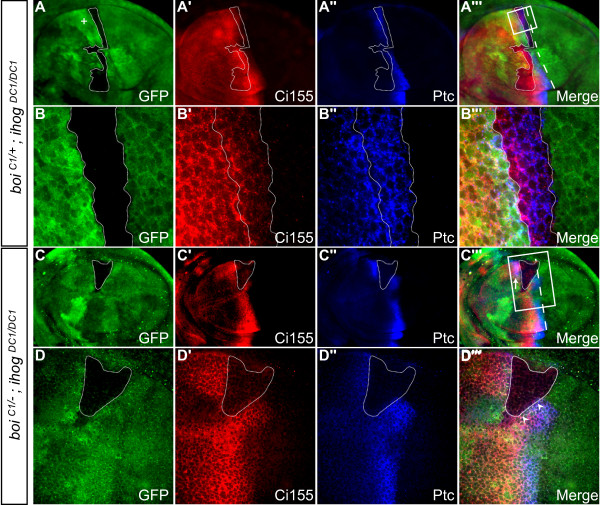Figure 4.
ihog and boi are required for high- and low-threshold responses to Hh pathway activation. All panels show third instar wing imaginal discs with anterior to the left. (A-B''') Control showing large GFP-negative ihogDC1/DC1 clone (outlined with dotted line) in a boiC1/+ heterozygote. The adjacent twin-spot is marked by the high level of GFP staining (the plus sign in (A)). (A-A''') Low magnification view. The white dashed line in (A''') marks the normal position of the anterior-posterior boundary. (B-B''') Higher magnification view of boxed area in (A'''). Ptc (blue) is a high-threshold Hh target that is normally activated in anterior cells immediately adjacent to the anterior-posterior compartment boundary, while Ci155 (red) accumulates in cells positioned more anteriorly in response to lower levels of Hh signaling. In this large anterior control clone, there is normal expression of Ptc and Ci155 and no segregation into posterior territory. (C-D''') An ihogDC1/DC1 clone (dotted line) in a boiC1/- mutant. (C-C''') Low magnification view. White dashed line in (C''') marks the normal position of the anterior-posterior boundary. (D-D''') Higher magnification view of boxed area in (C'''). Clones lacking both ihog and boi were unable to express Ptc or accumulate high levels of Ci155 (GFP-negative, dotted line). High levels of Ptc and Ci155 in cells immediately adjacent to clones (arrowheads in (D''')) indicate that Ihog and Boi are required cell-autonomously in Hh responding cells, and expression of these markers immediately anterior to the clone (arrow in (C''')) indicates that loss of Ihog and Boi fails to sequester Hh activity in the clone.

